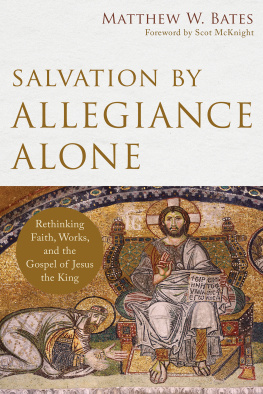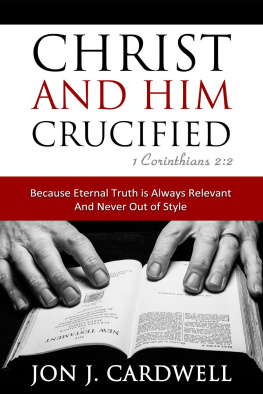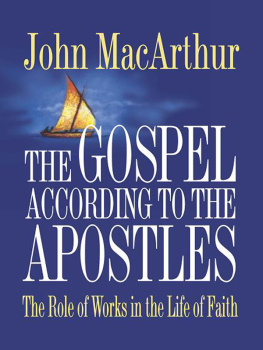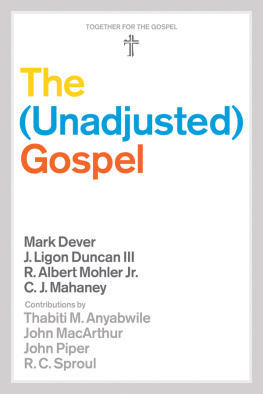
2017 by Matthew W. Bates
Published by Baker Academic
a division of Baker Publishing Group
P.O. Box 6287, Grand Rapids, MI 49516-6287
www.bakeracademic.com
Ebook edition created 2017
All rights reserved. No part of this publication may be reproduced, stored in a retrieval system, or transmitted in any form or by any meansfor example, electronic, photocopy, recordingwithout the prior written permission of the publisher. The only exception is brief quotations in printed reviews.
Library of Congress Cataloging-in-Publication Data is on file at the Library of Congress, Washington, DC.
ISBN 978-1-4934-0673-9
Unless otherwise indicated, all Scripture translations are the authors own.
Scripture quotations labeled ESV are from The Holy Bible, English Standard Version (ESV), copyright 2001 by Crossway, a publishing ministry of Good News Publishers. Used by permission. All rights reserved. ESV Text Edition: 2011
Scripture quotations labeled NRSV are from the New Revised Standard Version of the Bible, copyright 1989, by the Division of Christian Education of the National Council of the Churches of Christ in the United States of America. Used by permission. All rights reserved.
Scripture quotations labeled KJV are from the King James Version of the Bible.
With gratitude and love to my marvelous parents, Michael G. Bates and Linda K. Bates
C ONTENTS
F OREWORD
The Churchs one foundation is Jesus Christ her Lord, proclaims the hymnist Samuel Stone. Upon the absolutely secure foundation of Jesus, the true gospel sits as a secondary substructure, undergirding the universal church. So when the gospel is compromised, despite its unshakable foundation, the building leans, sways, and slides. Unfortunately the gospel preached in much of the Western world has corroded and destabilized the churchand the deconstruction continues at an alarming pace. But the problem is not just the pseudogospel that is being preached. It runs deeper. How so? The gospel message also includes a proper response, and misunderstandings about what constitutes an adequate response are further compromising the church and her mission to the world.
Without dismissing the real gains and genuine growth, few would deny that the church in the West is not what it could have been and ought to be. Attendance is down; holiness is wanting; love is superficial; discipleship is thin; seminaries are struggling to find a young generation even interested in church ministry. The attempt to bolster attendance, to press for more holiness, to summon more to be shaped by love, and the constant plea for more focus on discipleship and deeper theological preparation proves that criticisms of the church are on target. But the solutions arent working. Why? Jesus the foundation is rock-solid, but the secondary and tertiary substructures are weak. When the gospel and its proper response have been eroded, recarpeting the foyer, rearranging the pews, and reshingling the roof will not help. The changeless foundation of the church can never be moved; it is the shoddily built gospel and faith substructure that is in need of renovation.
Salvation by Allegiance Alone is an exciting book because it takes us to that place of renovation: a rediscovery of the genuine gospel and its truly fitting response. As Matthew Bates shows, the gospel is the power-releasing story of how Jesus became king and the only adequate response is allegiance alone . But unfortunately the clarion call to allegiance in the New Testament has all too often been muted by misguided teachings about grace, or worse, grace-ism.
Regarding this grace-ism, who has not heard that grace means Gods riches at Christs expense or that it means pure gift or Gods unconditional love or, from a different angle, Gods mercy to those who dont deserve it. One also hears what follows: you dont have to do a thing, you dont have to worry, its all been done for you, just sit back and relax in this unconditional grace of God. One wonders if proponents of such theological understandings have spent much time examining what grace means in the New Testament (and the Old Testament, where it is also taught).
Among other stimulating insights in Salvation by Allegiance Alone , Matthew Bates helpfully brings to our attention the important work of John Barclay on grace, Paul and the Gift . We discover that grace is more complex than we might have otherwise imagined. In fact, Bates, following Barclay, contends there are six dimensions of grace that different authors and theologians may or may not perfect or take to their extreme limit. (For these six dimensions and some implications, see chap. 5, sec. Grace and Allegiance Alone?) Yet for many today, grace has been reduced to only two or three of these six themes. Grace only means Gods superabundance, Gods priority, and most especially the incongruity of Gods gift to sinners. Anything else is not grace. But listen to what we discover: gift-giving, or grace, in the ancient world always required reciprocation .
Grace, then, was according to the apostle Pauls contemporary, the philosopher Seneca, much like playing a game of catch:
There is no doubt that when the ball is dropped it could be the fault of either the thrower or the catcher. The game goes along nicely when the ball is thrown and caught by both in a suitable manner, back and forth between the hands of thrower and catcher. But a good player needs to throw the ball differently to a tall partner and to a short one. It is the same with granting benefits: unless it is adjusted to the social roles of both parties, the giver and the recipient, the benefit will not actually be given by the one nor be received by the other in the right manner. ( On Benefits 2.17; Griffin and Inwood)
Continuing, Seneca then explains the image, helping us to better understand the true nature of grace or gift-giving during the New Testament era: just as we give the short player a low throw so that he can make the catch and return the throw, but we give the tall player something different, so it should be with all cases of grace or gift-giving. Seneca suggests that all givers and receivers should monitor and adjust the gift-giving so that the cycle of grace can be perpetuated.
Notice that in antiquity a gift implicated the person who received the gift to respond with some kind of gift given back to the original giver. Of course, the receiver of a gift responds by beginning with gratitude, but ideally gratitude turns into a reciprocal gift. Matthew Bates demonstrates in this book that grace in the New Testament fits this pattern: Gods superabundant, prior gift is granted without regard to our relative worth, but the reception of Gods gift demands a return gift from us, a response of grateful discipleship marked by allegiance to King Jesus.
Allegiance, then, is at the heart of grace as it was perceived in the ancient world. Grace was not simplyor everpure gift in spite of what some say today. One must define terms by their usage not by our contemporary beliefs or usages. Grace can both be one hundred percent gift and at the same time summon the gifted person with an obligation, a heartfelt and intentional duty, to respond in gratitude and behavior in accordance with the new social bond created by the gift-givers gift. This grace runs right through the Old Testament, through Judaism, and into the New Testament. What distinguished the kind of Judaism that did not believe in Jesus and the one that did was not the appearance or absence of grace itself but how grace was understood . It is, then, a popular misunderstanding of Paul to conclude that grace did not obligate the Christianthe one who received Gods gift of Christ and redemptionto respond to God through real behavioral change. Grace in fact required a life of gratitude, praise, andheres the language from Matthew Batess outstanding book allegiance to Jesus as king.
Next page

















